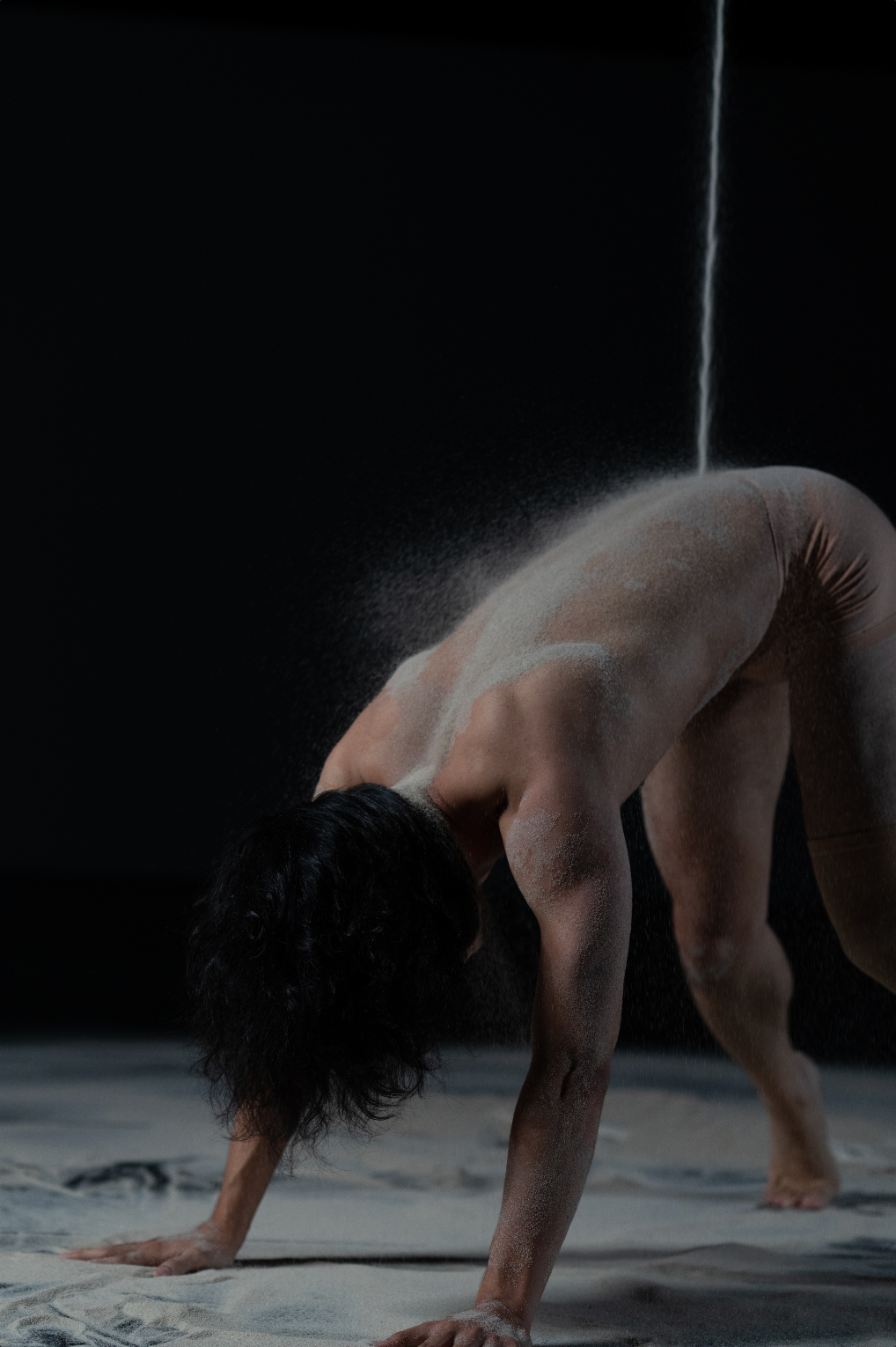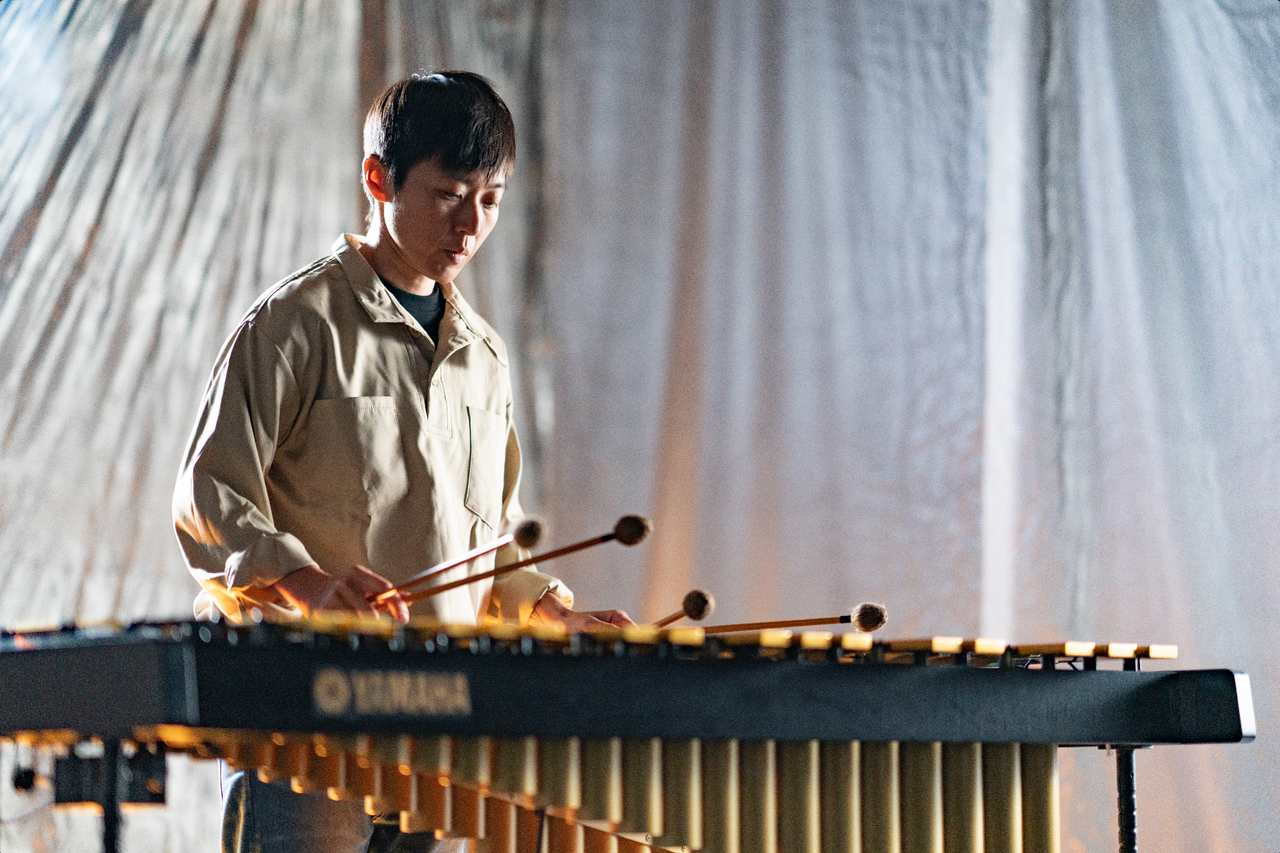The Eternal Zoo 永生動物園 | 2024
New Media Theater

“The Eternal Zoo” is a new media art theater work conceptualized and directed by artist Yen-Tzu Chang. It is a cross-disciplinary performance that integrates digital technology (Industrial Technology Research Institute - ITRI), percussion and synthesizer music (Hai-Ting Liao), AI visual design for theater (Kuo-Han Lee), and dance performance (Szu-Wei Liao). The story revolves around the exploration of the relationship between humans and other species, examining the act of watching animals in a zoo and the mythology that surrounds them. Using examples from Formosan sika deer, the Asian elephant Lin Wang, the Formosan black bear, the butterfly Boloria pales yangi, and the Formosan clouded leopard, the work delves into the aesthetic experience and philosophical reflection regarding humanity and life on earth.
Chapter 1: Rebirth
This chapter portrays the extinction and rebirth of the Formosan sika deer. Around 1969, the species became extinct in the wild, but in 1984, through careful breeding programs in zoos, the deer were reintroduced into the wild at Kenting. The rebirth of the Formosan sika deer, initially a meticulously planned effort by scholars and experts, symbolized humanity’s intention to return something to nature. However, this rebirth may have led to new issues, such as affecting the forest ecosystem.
Chapter 2: Celebration
Lin Wang, the beloved elephant, passed away in 2003, causing great sadness among many in Taiwan. During World War II, Lin Wang had served by transporting ammunition and food, and as the army moved through villages and towns, Lin Wang even performed to earn food and travel expenses. Initially stationed in a military camp in southern Taiwan, Lin Wang was transferred to the Taipei Zoo in 1954, where he was “married” to another elephant in a ceremony that was warmly welcomed and celebrated by the public.
Chapter 3: A Collapsing World
This chapter is inspired by the documentary The Death of a Formosan Black Bear and Taiwan’s historical title as the “Kingdom of Butterflies.” The documentary depicts conservationists’ efforts to rescue a black bear caught in a trap, highlighting the challenges of communicating with local residents. Ultimately, the bear is killed by a hunter, revealing the deep conflicts between wildlife conservation, legal regulations, and local cultural practices. Taiwan’s butterfly industry began during the Japanese colonial period, and by the 1960s, the butterfly processing trade resurged. Over the span of two decades, Taiwan exported over a billion butterflies. However, due to environmental changes, land development, and over-collection, many endemic species have become extinct.
Chapter 4: The Mythical Beast
The Formosan clouded leopard disappeared before it could be officially classified as a protected species, symbolizing the imbalance in nature and the irretrievable loss of wildlife. The final scene features the image of the clouded leopard, reflecting on human efforts in wildlife conservation and returning to the themes of the first chapter, exploring the complex relationship between humanity and the natural environment.
Time
Performance 1
November 1st (Fri), doors open at 19:00 (Taiwan time) / 12:00 (Germany time), performance starts at 19:30 (Taiwan time) / 12:30 (Germany time). A post-performance talk is scheduled for approximately 15-20 minutes.
Performance 2
November 2nd (Sat), doors open at 13:30 (Taiwan time) / 06:30 (Germany time), performance starts at 14:00 (Taiwan time) / 07:00 (Germany time). A post-performance talk is scheduled for approximately 15-20 minutes.
Site
Center for Art and Technology, Taipei National University of the Arts
(1 Hsueh-Yuan Road, 11201 Peitou, Taipei, Taiwan)
Concept Developer/Director:
Yen-Tzu Chang
Music Design/Percussionist:
Hai-Ting Liao
Choreography/Dancer:
Szu-Wei Liao
Visual Design: Kuo-Han Lee(Max)
Stage Manager: Chu-Hsin Cheng
Lighting Design:
Fang-Yu Chien
Surround Sound Engineering:
Zhih-Lin Chen
Stage Technology:
Bor-Yan Liu
Executive Producers:
Jing-Hang Lin, Vanessa Chen
Mapping Technology/AR Technology/AI Models:
Industrial Technology Research Institute
Taiwan Biological Relations Research Consultant:
Si-Ting Hsu
German Biological Relations/ Creative Research Consultant:
Bianka Hofmann Consulting
Dynamic Photography | Aquamarine Film
Still Photography | Ting-Chen Chang
Suona Recording | Ya-Nung Huang
Special Thanks | Tzu-Tien Hsiao
Advisor | Ministry of Culture of Taiwan
Counselor | Industrial Technology Research Institute
Organizer | Yeles Studio, TNUA Center for Art and Technology
Co-organizers | NTUA Center for Sound Arts and Acoustics Research
Cooperation | NTUA Innovation Center for Art and Technology
《永生動物園》由藝術家張晏慈概念發展與執導創作,一場跨越結合數位科技、打擊樂與合成器音樂演出(廖海廷)、劇場 AI 視覺設計(李國漢)、以及舞蹈表演(廖思瑋)的新媒體藝術劇場作品。故事圍繞在人類與其他物種關係的探討,從動物園的觀看行為到對動物神化的想像,以臺灣梅花鹿、亞洲象林旺、臺灣黑熊與楊氏淺色小豹蛺蝶、臺灣雲豹等野生動物與圈養動物為對象,探討之於人類、之於地球生命的美學體驗與哲學反思。
「第一章:重生 Rebirth」描述臺灣梅花鹿的滅絕與重生。1969年左右在野外滅絕,1984年透過動物園育種,在墾丁放養,臺灣梅花鹿的重生之路,最初雖然是學者專家的縝密計畫,象徵人類返還自然的心意,如今或許反而造成林地環境等另一層問題。
「第二章:歡慶 Celebration」林旺在2003年長眠,許多臺灣民眾非常難過。林旺在二戰期間擔任運輸砲彈、糧食的工作,甚至軍隊移動到不同鄉村小鎮時,以表演獲取糧食與旅費。抵臺初期仍然在南部軍營,直到1954年,台北市立動物園將林旺接到台北,並且與另一頭大象配對「結婚」,受到民眾歡迎與祝福。
「第三章:崩坍的世界 A Collapsing World」啟發自紀錄片《一隻臺灣黑熊之死》以及臺灣被稱為「蝴蝶王國」的歷史。紀錄片描述了保育人員拯救落入陷阱的黑熊,與當地居民溝通的過程。最終黑熊死於獵人槍下,揭示了野生動物保育、法律規範、以及地方文化的衝突。捕蝶產業起源於日治時期,1960年代,蝴蝶加工業再度興起,前後共二十年間,出口數量達上億隻。隨著環境變遷、土地開發以及過度捕捉,許多臺灣特有品種消失滅絕。
「第四章:神獸 The Mythical Beast 」臺灣雲豹在列入保育類動物前就已經消逝,象徵著自然界的失衡與無法挽回的消亡。最後的場景展現了雲豹的意象,反思人類的復育行動,回到第一章,探討我們與自然環境間的複雜關係。
11/1(五)19:00入場、19:30演出,有演後座談預計15-20分鐘。
11/2(六)13:30入場、14:00演出,有演後座談預計15-20分鐘。
藝術與科技中心 科技藝術館
11201臺北市北投區學園路一號 (國立臺北藝術大學 科技藝術館)
主創/導演 | 張晏慈
聲音現場演出 | 廖海廷
編舞/舞蹈演出 | 廖思瑋
影像設計 | 李國漢
音樂設計 | 噪音印製 廖海廷、何恭譱
舞台監督 | 程楚心
燈光設計 | 簡芳瑜
環繞音響工程 | 陳致霖
舞台技術 | 劉柏言
燈光技術指導 | 王墉
多聲道編程助理|應綻欣
執行製作 | 林竟航、陳美璇
Mapping技術/AR技術/AI模型 | 工業技術研究院 數位虛擬人實驗室
臺灣生物關係研究顧問 | 許絲婷
德國生物關係與創作研究顧問 | BIANKA HOFMANN CONSULTING
動態攝影|三月影像
平面攝影|張庭甄
嗩吶錄音|黃雅農
特別感謝|田孝慈 @hsiaotzu.tien
指導單位|文化部
輔導單位|工業技術研究院
主辦單位|國立臺北藝術大學藝術與科技中心、電慈學機組工作室
產學合作|國立臺灣藝術大學聲響藝術實驗中心
協辦單位|國立臺灣藝術大學科技藝術實驗中心

2024 The Eternal Zoo

2024 The Eternal Zoo

2024 The Eternal Zoo

2024 The Eternal Zoo

2024 The Eternal Zoo